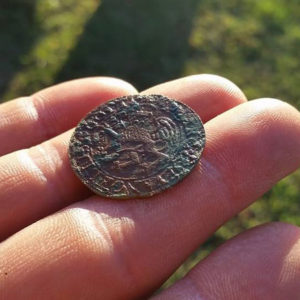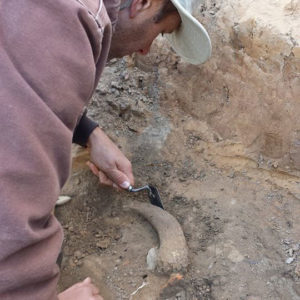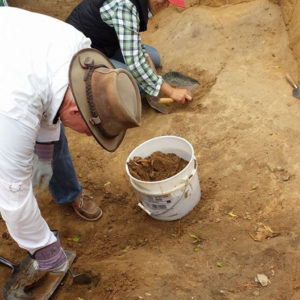It’s now likely that this summer’s work by the Jamestown Rediscovery team has uncovered a second fort period structure outside the James Fort’s original triangular palisade.
In the first years of the project the archaeologists excavated structure 165, “The Factory” building just outside the southeast bulwark of the fort. It appears that when colonists expanded James Fort into a five-sided space in 1608 they put a building at each of those new palisade corners.
“This building complements that one to the south. So there seems to be a pattern,” said Senior Jamestown Rediscovery Archaeologist Danny Schmidt.
A variety of techniques have brought into focus this feature at the northeast palisade corner, just to the side of the modern brick Preservation Virginia gate.
A Kentucky team brought a mobile unit of ground-penetrating radar to the site in early November. When they used the radar over the unexcavated portion of the feature, it measured the depth of the feature at about six feet—”which is pretty typical for the depth at which we find the cellars at the fort site,” Schmidt said.
The archaeologists also got a view of the feature from about 150 feet in the air using a drone provided by John Sutton, who volunteers on Jamestown Island and also runs his own private tour company in the Historic Triangle.
Schmidt said that from that height, “You could really see the cellar squaring up. You could see a rectangle form to it very well from that height.”
And the archaeologists troweling the soil have found postholes that would support a building about 22 feet long by about 14 feet wide and incorporated into the extended fort palisade itself, he said.
“When we last updated you, we weren’t entirely sure this was a cellar. But now we are,” Schmidt said. “We have a nice corner to the cellar. We have verified that there is indeed a posthole in that corner. And the posthole we found earlier this season at the corner of the fort addition appears to be tied in to this building. It lines up with two other postholes, including the one in the cellar.”
The archaeologists quartered the feature several months ago so they could clearly see the profile of the soil layers as they gradually work downward. They are still working in the first quarter and are now about four feet deep, Schmidt said.
The artifacts found recently in the feature also point to an early structure. Archaeologists found a copper alloy jetton made in Nuremburg, Germany, between 1580 and 1586, a time when Europeans still used Roman numerals and aided their calculations with such tokens.
The archaeologists have also found sturgeon scutes, pieces of turtle, and bones from a large bird such as a goose or turkey. “The earlier we are in the history, the more the colonists were foraging and scavenging for their food,” Schmidt said.
The team even found a complete horn from a goat. “That’s unusual. I’ve been here 20 years, and it’s the first one of those I’ve come across,” Schmidt said.
related images
- German copper jetton
- Goat horn found during excavations
- Dr. Kelso and Mary Anna Richardson excavating the newly discovered structure








